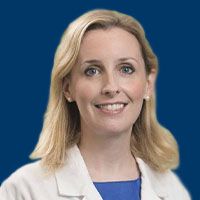Video
Dr Yu on the Investigation of BL-B01D1 in Lung Cancer
Author(s):
Helena A. Yu, MD, discusses findings from a phase 1 trial investigating the bispecific antibody-drug conjugate BL-B01D1, which is directed against both HER3 and EGFR, in patients with locally advanced or metastatic solid tumors such as non–small cell lung cancer and small cell lung cancer.
Helena A. Yu, MD, associate attending physician, Memorial Sloan Kettering Cancer Center, discusses findings from a phase 1 trial (NCT05194982) investigating the bispecific antibody-drug conjugate (ADC) BL-B01D1, which is directed against both HER3 and EGFR, in patients with locally advanced or metastatic solid tumors such as non–small cell lung cancer (NSCLC), small cell lung cancer (SCLC), nasopharyngeal carcinoma, and head and neck squamous cell carcinoma.
Dr Yu on the Efficacy of BL-B01D1 in Advanced Solid Tumors
The findings from this trial, presented at the 2023 ASCO Annual Meeting at a median follow-up of 4.1 months, included data from 195 patients with at least 1 tumor assessment, 45.3% of whom responded to treatment with BL-B01D1. These are promising early findings from a phase 1 dose-escalation study, Yu says. When overall response rate (ORR) was stratified by tumor type, the ADC generated the highest ORR, 63.2%, in patients with EGFR-mutant NSCLC. This finding was expected based on the prevalence of both EGFR and HER3 in NSCLC, Yu notes.
Dr Yu on BL-B01D1 in NSCLC and SCLC
The patients with NSCLC who were enrolled in the trial were divided into 2 groups: those with EGFR-mutant disease and those with EGFR wild-type disease. All patients with EGFR-mutant NSCLC had received prior EGFR TKIs, most of which were third-generation EGFR TKIs such as osimertinib (Tagrisso), and 74% of these patients had received prior platinum-based chemotherapy. Given the heavily pretreated nature of the EGFR-mutant NSCLC population, the 63.2% ORR in the third-line setting and beyond was notable, according to Yu.
Patients with EGFR wild-type NSCLC have limited treatment options after first-line chemoimmunotherapy and no targeted therapies, Yu explains. In this population, BL-B01D1 elicited an ORR of 44.9%, which supports the further investigation of ADCs in patients with NSCLC without driver mutations, Yu emphasizes.
This trial enrolled a small SCLC cohort consisting of 7 patients, of whom 1 achieved a partial response. The small size of the SCLC cohort in this phase 1 trial demonstrates the importance of further research in this population, Yu concludes.









